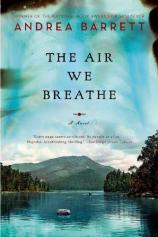The Air We Breathe
Review
The Air We Breathe
In 1996, Andrea Barrett's National Book Award–winning story collection SHIP FEVER was published to great critical acclaim. Apparently, book reviewers and readers were not the only ones who found much to treasure in this collection of stories that explore history, science and nature. Barrett herself has returned again and again to the characters and themes she introduced in that collection. From the brilliant novel VOYAGE OF THE NARWHAL to her most recent collection, 2002's SERVANTS OF THE MAP, Barrett has created what amounts to a whole extended family of characters whose passions, desires and ambitions surface and resurface in her fiction.
Now, with her new book THE AIR WE BREATHE, Barrett offers readers another interconnected historical novel (this one is set in 1916) that feels simultaneously historically grounded and accurate in its facts and absolutely contemporary and relevant in its themes. It’s set in Tamarack State, a tuberculosis sanatorium in the Adirondack region of northern New York State. A public institution for indigent patients, the hospital (unlike the genteel convalescent homes for wealthy invalids) houses mostly immigrants, recent transplants to the United States from places like Russia, eastern Europe and Germany. Many of these patients, like newly-arrived Leo Marburg, were professionals or highly skilled workers in the old country. Here, though, they are treated as common laborers --- or, eventually, as worse.
Into this milieu comes Miles Fairchild, an industrialist and amateur paleontologist. He's staying down the road at one of the convalescent homes, but he's eager to start a Wednesday afternoon conversation group at Tamarack State. From its origins as a small group of patients listening to Miles's natural history lecures, the group expands, allowing its members not only the opportunity to socialize but also to recapture the lives and knowledge they knew before.
This idyllic environment, however, is doomed to failure. Not only are its members truly ill, but world events are conspiring against it as well. The United States has just entered World War I, and national loyalties are constantly tested. When unrequited love, jealousy and suspicion collide, tragedy cannot be far behind.
Unlike much of Barrett's previous fiction, THE AIR WE BREATHE does not take place on a grand scale or involve groundbreaking discoveries or epic voyages. Instead, it takes place on a small canvas, indeed, set almost entirely within the walls of the sanatorium. In fact, the whole novel, like its setting, is restrained. Barrett still includes her trademark fascination with scientific and sensual passions alike, using both historical fact and stylistic conventions to evoke a particular time and place.
Barrett also plays skillfully with style here, utilizing a first-person plural narrator to represent the collective convalescents who narrate the novel's events. Fluid, quickly shifting perspectives move from this weary "we" to an omniscient third-person point of view that probes into the minds and histories of all its characters. Rewarding both longtime readers who will recognize the mention of familiar names and thoughtful readers who will marvel at her stylistic facility, THE AIR WE BREATHE will leave Barrett’s readers reflecting on how her themes of war, suspicion and intolerance still offer contemporary relevance nearly a century after the novel's setting.
Reviewed by Norah Piehl on December 22, 2010
The Air We Breathe
- Publication Date: October 17, 2008
- Genres: Fiction
- Paperback: 320 pages
- Publisher: W. W. Norton & Company
- ISBN-10: 0393333078
- ISBN-13: 9780393333077










